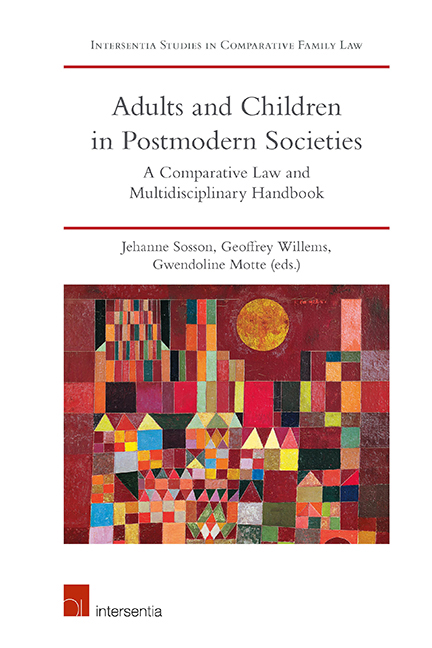Book contents
- Frontmatter
- Contents
- List of Cases
- List of Contributors
- Introduction
- PART I NATIONAL REPORTS ON LEGAL REGULATIONS OF RELATIONSHIPS BETWEEN ADULTS AND CHILDREN
- PART II INTERDISCIPLINARY APPROACH
- PART III INTERNATIONAL LAW INSIGHTS
- PART IV COMPARATIVE APPROACH
- Parentage, Parenthood and Parental Responsibility in Traditional Families
- Emergence and Development of Artificial Reproductive Technologies
- Multiplication of Potential Social and Emotional Ties
- The Future of Legal Relationships between Adults and Children: Complex Issues and Hybrid Solutions
- General Conclusion: The Challenge of Transparent and Inclusive Parenthood/Parentality in a Pluralist and Cosmopolitan Context
- About the Editors
Multiplication of Potential Social and Emotional Ties
from PART IV - COMPARATIVE APPROACH
Published online by Cambridge University Press: 26 June 2019
- Frontmatter
- Contents
- List of Cases
- List of Contributors
- Introduction
- PART I NATIONAL REPORTS ON LEGAL REGULATIONS OF RELATIONSHIPS BETWEEN ADULTS AND CHILDREN
- PART II INTERDISCIPLINARY APPROACH
- PART III INTERNATIONAL LAW INSIGHTS
- PART IV COMPARATIVE APPROACH
- Parentage, Parenthood and Parental Responsibility in Traditional Families
- Emergence and Development of Artificial Reproductive Technologies
- Multiplication of Potential Social and Emotional Ties
- The Future of Legal Relationships between Adults and Children: Complex Issues and Hybrid Solutions
- General Conclusion: The Challenge of Transparent and Inclusive Parenthood/Parentality in a Pluralist and Cosmopolitan Context
- About the Editors
Summary
INTRODUCTION
This part of the book aims at exploring how social and emotional ties that have developed between adults and children may be recognised and protected by law within ‘non-traditional’ families, in three different contexts: (1) adoption; (2) step families; and (3) foster families.
In these different contexts, the relationship between adults and children is sometimes protected via an adoption (general adoption, step-child adoption or foster child adoption) with the objective being to establish a parenthood link between the adult and the child. The relationship can also be protected via measures aiming at protecting the socio-emotional link created between the child and the adult by conferring parental responsibilities on the adult, and/or via measures aiming at protecting the child financially, focusing on the intrafamily financial maintenance of the child, and/or by residence rights or contact rights between the child and the adult.
ADOPTION
Adoption is organised in almost all the reviewed jurisdictions but there are variations as to: (1) the available types of adoptions; (2) the requirements for adoption; and (3) the links maintained with the birth family.
Before reviewing and analysing the diversity of the national approaches, it is important to recall the obvious. On the one hand, adoption may be used as an end to create ex-nihilo a relationship between adults and children, where there is no pre-existing link between the adoptive child and the adoptive parent(s) and when the adoption of an orphan child is contemplated by (an) adult(s) as a way of becoming parent(s). In this case the adoption creates a legal relationship as well as a brand new social and emotional link. On the other hand, adoption may be used as a means of recognising and protecting a pre-existing social and emotional relationship, when the adoption of a child is contemplated, for example, by his/her step-parent(s) or foster parent(s). In this case, adoption only establishes a legal link, which consolidates an already existing socio-affective link.
ADOPTION SCHEMES
Amongst the reviewed jurisdictions, different types of adoption are available. Some offer adoption schemes whereby the adoptive child is fully integrated into the adoptive family. Others offer schemes whereby the adoptive child is not fully integrated and the initial parenthood link is maintained.
- Type
- Chapter
- Information
- Adults and Children in Postmodern SocietiesA Comparative Law and Multidisciplinary Handbook, pp. 793 - 824Publisher: IntersentiaPrint publication year: 2019



